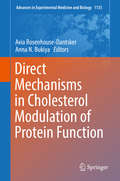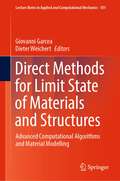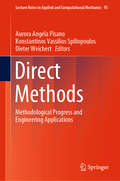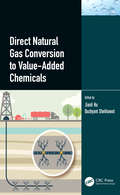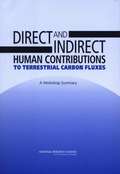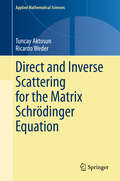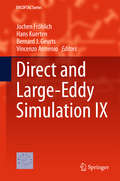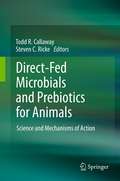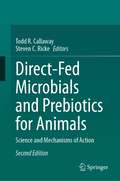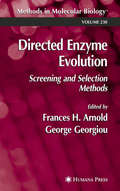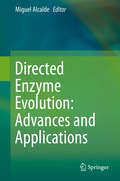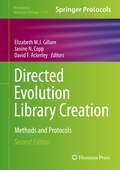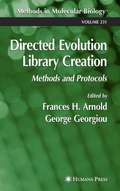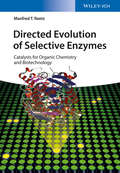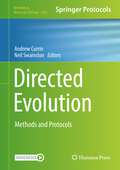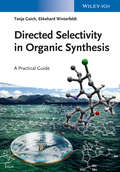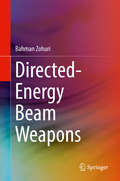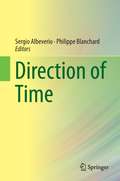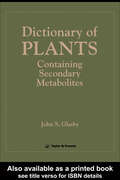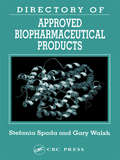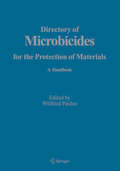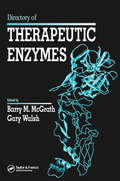- Table View
- List View
Direct Mechanisms in Cholesterol Modulation of Protein Function (Advances in Experimental Medicine and Biology #1135)
by Avia Rosenhouse-Dantsker Anna N. BukiyaIn this book, renowned scientists describe how cholesterol interacts with various proteins. Recent progress made in the high-resolution visualization of cholesterol-protein interactions using crystallography and cryogenic electron microscopy has substantially advanced the knowledge of critical features. These features enable specific recognition of the cholesterol molecule by proteins, a process that was built on earlier studies using binding assays, computational modeling and site-directed mutagenesis. Direct Mechanisms in Cholesterol Modulation of Protein Function offers comprehensive insights into the current understanding of cholesterol-driven modulation of protein function via direct sensing. Its nine chapters are organized into two distinct parts. In the first part, the chapters introduce the reader to the general characteristics of cholesterol binding sites in proteins. This part starts with a tour into common cholesterol recognition motifs, followed by an overview of the major classes of steroid-binding proteins. It then continues with two chapters that present a comprehensive analysis of molecular and structural characteristics of cholesterol binding sites in transmembrane and soluble protein domains. In the second part of the book, examples of cholesterol binding sites and consequences of specific cholesterol recognition for protein function are presented for G protein-coupled receptors, ion channels and cholesterol-transporting proteins. The book is valuable for undergraduate and graduate students in biochemistry and nutrition, as well as basic science and medical researchers with a keen interest in the biophysical properties of cholesterol and physiological consequences of cholesterol presence in biological systems.
Direct Methods for Limit State of Materials and Structures: Advanced Computational Algorithms and Material Modelling (Lecture Notes in Applied and Computational Mechanics #101)
by Dieter Weichert Giovanni GarceaThis book provides an overview of direct methods, such as limit and shakedown analysis, which are intended for avoiding cumbersome step-by-step calculations to determine the limit states of mechanical structures under monotone, cyclic or variable actions with unknown loading history. The book comprises several contributions that demonstrate how tremendous advances in numerical methods, especially in optimization, have contributed to the success of direct methods and their applicability to practical engineering problems in structural mechanics and mechanics of materials. The contents reflect the outcomes of the workshop “Direct Methods for Limit State of Materials and Structures,” held in Cosenza, Italy in June 2022.
Direct Methods: Methodological Progress and Engineering Applications (Lecture Notes in Applied and Computational Mechanics #95)
by Dieter Weichert Aurora Angela Pisano Konstantinos Vassilios SpiliopoulosThis book provides an overview of direct methods such as limit and shakedown analysis, which are intended to do away with the need for cumbersome step-by-step calculations and determine the loading limits of mechanical structures under monotone, cyclic or variable loading with unknown loading history. The respective contributions demonstrate how tremendous advances in numerical methods, especially in optimization, have contributed to the success of direct methods and their practical applicability to engineering problems in structural mechanics, pavement and general soil mechanics, as well as the design of composite materials. The content reflects the outcomes of the workshop “Direct Methods: Methodological Progress and Engineering Applications,” which was offered as a mini-symposium of PCM-CMM 2019, held in Cracow, Poland in September 2019.
Direct Natural Gas Conversion to Value-Added Chemicals
by Jianli Hu Dushyant ShekhawatDirect Natural Gas Conversion to Value-Added Chemicals comprehensively discusses all major aspects of natural gas conversion and introduces a broad spectrum of recent technological developments. Specifically, the book describes heterogeneous and homogeneous catalysis, microwave-assisted conversion, non-thermal plasma conversion, electrochemical conversion, and novel chemical looping conversion approaches. Provides an excellent benchmark resource for the industry and academics Appeals to experienced researchers as well as newcomers to the field, despite the variety of contributing authors and the complexity of the material covered Includes all aspects of direct natural gas conversion: fundamental chemistry, different routes of conversion, catalysts, catalyst deactivation, reaction engineering, novel conversion concepts, thermodynamics, heat and mass transfer issues, system design, and recent research and development Discusses new developments in natural gas conversion and future challenges and opportunities This book is as an excellent resource for advanced students, technology developers, and researchers in chemical engineering, industrial chemistry, and others interested in the conversion of natural gas.
Direct and Indirect Human Contributions to Terrestrial Carbon Fluxes: A Workshop Summary
by Stephanie Johnson Rob CoppockHuman-induced climate change is an important environmental issue worldwide, as scientific studies increasingly demonstrate that human activities are changing the Earth’s climate. Even if dramatic reductions in emissions were made today, some human-induced changes are likely to persist beyond the 21st century. The Kyoto Protocol calls for emissions reporting that separates out management-induced changes in greenhouse gases from those changes caused by indirect human effects (e.g., carbon dioxide fertilization, nitrogen deposition, or precipitation changes), natural effects, and past practices on forested agricultural lands.This book summarizes a September 2003 workshop where leaders from academia, government and industry came together to discuss the current state of scientific understanding on quantifying direct human-induced change in terrestrial carbon stocks and related changes in greenhouse gas emissions and distinguishing these changes from those caused by indirect and natural effects.
Direct and Inverse Scattering for the Matrix Schrödinger Equation (Applied Mathematical Sciences #203)
by Tuncay Aktosun Ricardo WederAuthored by two experts in the field who have been long-time collaborators, this monograph treats the scattering and inverse scattering problems for the matrix Schrödinger equation on the half line with the general selfadjoint boundary condition. The existence, uniqueness, construction, and characterization aspects are treated with mathematical rigor, and physical insight is provided to make the material accessible to mathematicians, physicists, engineers, and applied scientists with an interest in scattering and inverse scattering. The material presented is expected to be useful to beginners as well as experts in the field. The subject matter covered is expected to be interesting to a wide range of researchers including those working in quantum graphs and scattering on graphs. The theory presented is illustrated with various explicit examples to improve the understanding of scattering and inverse scattering problems. The monograph introduces a specific class of input data sets consisting of a potential and a boundary condition and a specific class of scattering data sets consisting of a scattering matrix and bound-state information. The important problem of the characterization is solved by establishing a one-to-one correspondence between the two aforementioned classes. The characterization result is formulated in various equivalent forms, providing insight and allowing a comparison of different techniques used to solve the inverse scattering problem. The past literature treated the type of boundary condition as a part of the scattering data used as input to recover the potential. This monograph provides a proper formulation of the inverse scattering problem where the type of boundary condition is no longer a part of the scattering data set, but rather both the potential and the type of boundary condition are recovered from the scattering data set.
Direct and Large-Eddy Simulation IX
by Jochen Fröhlich Hans Kuerten Bernard J. Geurts Vincenzo ArmenioThis volume reflects the state of the art of numerical simulation of transitional and turbulent flows and provides an active forum for discussion of recent developments in simulation techniques and understanding of flow physics. Following the tradition of earlier DLES workshops, these papers address numerous theoretical and physical aspects of transitional and turbulent flows. At an applied level it contributes to the solution of problems related to energy production, transportation, magneto-hydrodynamics and the environment. A special session is devoted to quality issues of LES. The ninth Workshop on 'Direct and Large-Eddy Simulation' (DLES-9) was held in Dresden, April 3-5, 2013, organized by the Institute of Fluid Mechanics at Technische Universität Dresden. This book is of interest to scientists and engineers, both at an early level in their career and at more senior levels.
Direct-Fed Microbials and Prebiotics for Animals
by Todd R. Callaway Steven C. RickeThe practice of supplementing direct fed microbial and prebiotic additives to domestic animals during growth is becoming more widespread in food animal production. Beneficial effects particularly in cattle, pigs and poultry, including improved general health, foodborne pathogen reduction, more efficient food utilization, faster growth rate and increased milk and egg production are common results. The success associated with direct fed microbial and prebiotic applications in multiple species ensures their continued commercialization and the widespread use of such additives. However, several fundamental questions remain about how and why probiotic products work, and which kind of probiotic products are best for specific production scenarios. It appears that early establishment and retention of an ecological balance in the gastrointestinal tract is an important first step for an external biological additive to be effective in young animals. Therefore, it is possible that the effectiveness of direct fed microbials and prebiotics in some animal species may only be an indirect consequence of speeding up the establishment and succession of the dominant microflora characteristic of the adult gastrointestinal tract. Consequently, an understanding of the key processes during establishment of microflora in the gastrointestinal system that lead to the subsequent fermentation characteristics and ecological balance exhibited by the highly protective microflora is needed. Several additional areas of future research directions are also suggested for further development and implementation of these biological approaches as new molecular and drug delivery technologies become available. Continued research on direct fed microbials and prebiotics in general should markedly expand their commercial applications.
Direct-Fed Microbials and Prebiotics for Animals: Science and Mechanisms of Action
by Todd R. Callaway Steven C. RickeIn this exciting update, readers will learn how feeding direct-fed microbials (including eubiotics, postbiotics, prebiotics, and synbiotics) is becoming increasingly widespread during food animal production. Animal production must improve efficiency of growth, and the use of direct-fed microbial and prebiotic additives to domestic animals has become widely accepted and utilized. The benefits of probiotic-type approaches in cattle, pigs, fish, and poultry, include improved general animal health, reduced foodborne pathogen populations, increased growth rate and feed efficiency, improved milk and egg production, and have been reported world-wide. Successes from probiotic approaches in multiple species have ensured their adoption; however, several fundamental questions remain. Early establishment and retention of an ecological balance in the gastrointestinal tract is an important first step for an external biological additive to be effective in young animals, suggesting that some of the benefits of direct-fed microbials may be due to an early establishment of a “normal” native gut microbial population. Research has indicated that the establishment of a normal population can enhance gut epithelial integrity, preventing inflammation and improving animal health. Thus, it is important that we understand the key processes that occur during the establishment of the gut microbial population that can impact gastrointestinal fermentation and provide protection against pathogens of the animals and of human consumers. Knowing how these processes work and how they impact animal energy and protein expenditures can guide further improvements of available and future commercial products. Exciting research opportunities are discussed in this book, examining different characteristics of DFMs that are fed to animals to meet different production demands in different production scenarios (e.g., beef versus dairy versus swine versus fin fish). The advent of molecular and next-generation sequencing offers methods of developing tailored DFMs, and of early detection of successful DFM establishment in the gut. These techniques will further deepen our insight into understanding the microbial population of the gut and how these populations impact animal health, food safety, and sustainability of animal-derived protein production.
Direct-to-Consumer Genetic Testing: Summary of a Workshop
by Institute of Medicine National Research Council of the National AcademiesToday, scores of companies, primarily in the United States and Europe, are offering whole genome scanning services directly to the public. The proliferation of these companies and the services they offer demonstrate a public appetite for this information and where the future of genetics may be headed; they also demonstrate the need for serious discussion about the regulatory environment, patient privacy, and other policy implications of direct-to-consumer (DTC) genetic testing. Rapid advances in genetic research already have begun to transform clinical practice and our understanding of disease progression. Existing research has revealed a genetic basis or component for numerous diseases, including Parkinson's disease, Alzheimer's disease, diabetes, heart disease, and several forms of cancer. The availability of the human genome sequence and the HapMap, plummeting costs of high-throughput screening, and increasingly sophisticated computational analyses have led to an explosion of discoveries of linkages between patterns of genetic variation and disease susceptibility. While this research is by no means a straight path toward better public health, improved knowledge of the genetic linkages has the potential to change fundamentally the way health professionals and public health practitioners approach the prevention and treatment of disease. Realizing this potential will require greater sophistication in the interpretation of genetic tests, new training for physicians and other diagnosticians, and new approaches to communicating findings to the public. As this rapidly growing field matures, all of these questions require attention from a variety of perspectives. To discuss some of the foregoing issues, several units of the National Academies held a workshop on August 31 and September 1, 2009, to bring together a still-developing community of professionals from a variety of relevant disciplines, to educate the public and policy-makers about this emerging field, and to identify issues for future study. The meeting featured several invited presentations and discussions on the many technical, legal, policy, and ethical questions that such DTC testing raises, including: (1) overview of the current state of knowledge and the future research trajectory; (2) shared genes and emerging issues in privacy; (3) the regulatory framework; and (4) education of the public and the medical community.
Directed Enzyme Evolution
by George Georgiou Frances H. ArnoldSeasoned practitioners from many leading laboratories describe their best readily reproducible screening strategies for isolating useful clones. These techniques have been optimized for sensitivity, high throughput, and robustness, and are of proven utility for directed evolution purposes. The assays presented use a variety of techniques, including genetic complementation, microtiter plates, solid-phase screens with colorimetric substrates, and flow cytometric screens. An accompanying volume, Directed Evolution Library Creation: Methods and Protocols (ISBN 1-58829-285-1), describes readily reproducible methods for the creation of mutated DNA molecules and DNA libraries. Copy for Both Volumes Directed Evolution Library Creation: Methods and Protocols and Directed Enzyme Evolution: Screening and Selection Methods constitute an extraordinary collection of all the key methods used today for directed evolution research. Described in step-by-step detail to ensure robust experimental results, these methods will enable both newcomers and more experienced investigators to design and implement directed evolution strategies for the engineering of novel proteins. The first volume describes methods for the creation of mutated DNA molecules, or DNA libraries, encoding variants of desired proteins. The second volume describes methods for screening DNA libraries to isolate mutant proteins that exhibit a specified function.
Directed Enzyme Evolution: Advances and Applications
by Miguel AlcaldeThis book focuses on some of the most significant advances in enzyme engineering that have been achieved through directed evolution and hybrid approaches. On the 25th anniversary of the discovery of directed evolution, this volume is a tribute to the pioneers of this thrilling research field, and at the same time provides a comprehensive overview of current research and the state of the art. Directed molecular evolution has become the most reliable and robust method to tailor enzymes, metabolic pathways or even whole microorganisms with improved traits. By mirroring the Darwinian algorithm of natural selection on a laboratory scale, new biomolecules of invaluable biotechnological interest can now be engineered in a manner that surpasses the boundaries of nature. The volume is divided into two sections, the first of which provides an update on recent successful cases of enzyme ensembles from different areas of the biotechnological spectrum, including tryptophan synthases, unspecific peroxygenases, phytases, therapeutic enzymes, stereoselective enzymes and CO2-fixing enzymes. This section also provides information on the directed evolution of whole cells. The second section of the book summarizes a variety of the most applicable methods for library creation, together with the future trends aimed at bringing together directed evolution and in silico/computational enzyme design and ancestral resurrection.
Directed Evolution Library Creation
by Elizabeth M.J. Gillam Janine N. Copp David AckerleyDirected Evolution Library Creation: Methods and Protocols, Second Edition presents user-friendly protocols for both proven strategies and cutting-edge approaches for the creation of mutant gene libraries for directed evolution. As well as experimental methods, information on current computational approaches is provided in a user-friendly format that will allow researchers to make informed choices without needing to comprehend the full technical details of each algorithm. Directed evolution has become a fundamental approach for engineering proteins to enhance activity and explore structure-function relationships, and has supported the rapid development of the field of synthetic biology over the last decade. Divided into three convenient sections, topics include point mutagenesis strategies, recombinatorial methods wherein genetic diversity is sourced from multiple parental genes that are combined via either homology-dependent or -independent techniques and a variety of computational methods to guide the design and analysis of mutant libraries. Written in the successful Methods in Molecular Biology series format, chapters include introductions to their respective topics, lists of the necessary materials and reagents, step-by-step, readily reproducible protocols and notes on troubleshooting and avoiding known pitfalls. Authoritative and easily accessible, Directed Evolution Library Creation: Methods and Protocols, Second Edition will serve as a reliable manual for both novice and experienced protein engineers and synthetic biologists and will enable further technical innovation and the exploitation of directed evolution for a deeper understanding of protein design and function.
Directed Evolution Library Creation
by George Georgiou Frances H. ArnoldA comprehensive compendium of cutting-edge protocols for the generation of molecular diversity. Described in step-by-step detail to ensure experimental success, these protocols include readily reproducible methods for random mutagenesis of entire genes or segments of genes, for homologous and nonhomologus recombination, and for constructing in vivo libraries in bacteria and yeast. In addition to the various protocols for creating libraries, this volume also describes ways to analyze libraries, particularly those made by recombination. An accompanying volume, Directed Enzyme Evolution: Screening and Selection Methods (ISBN: 1-58829-286-X), is devoted entirely to selection and screening methods that can be applied to the directed evolution of enzymes. Copy for Both Volumes Directed Evolution Library Creation: Methods and Protocols and Directed Enzyme Evolution: Screening and Selection Methods constitute an extraordinary collection of all the key methods used today for directed evolution research. Described in step-by-step detail to ensure robust experimental results, these methods will enable both newcomers and more experienced investigators to design and implement directed evolution strategies for the engineering of novel proteins. The first volume describes methods for the creation of mutated DNA molecules, or DNA libraries, encoding variants of desired proteins. The second volume describes methods for screening DNA libraries to isolate mutant proteins that exhibit a specified function.
Directed Evolution for Development and Production of Bioactive Agents
by Daniel TalmageIn 2012, the Defense Intelligence Agency (DIA) approached the National Research Council and asked that a committee be formed to develop a list of workshop topics to explore the impact of emerging science and technology. This book explains the objectives of the workshop.
Directed Evolution of Selective Enzymes: Catalysts for Organic Chemistry and Biotechnology
by Manfred T. ReetzAuthored by one of the world's leading organic chemists, this authoritative reference provides an overview of basic strategies in directed evolution and introduces common gene mutagenesis, screening and selection methods. Throughout the text, emphasis is placed on methodology development to maximize efficiency, reliability and speed of the experiments and to provide guidelines for efficient protein engineering. Professor Reetz highlights the application of directed evolution experiments to address limitations in the field of enzyme selectivity, substrate scope, activity and robustness. He critically reviews recent developments and case studies, takes a look at future applications in the field of organic synthesis, and concludes with lessons learned from previous experiments.
Directed Evolution: Methods and Protocols (Methods in Molecular Biology #2461)
by Andrew Currin Neil SwainstonThis volume explores the latest techniques used by researchers to study directed evolution (DE) at each stage of the Design-Build-Test-Learn cycle. Chapters in this book cover topics such as designing overlap extension PCR primers for protein mutagenesis; antha-guided automation of Darwin assembly for the construction of bespoke gene libraries; rapid cloning of random mutagenesis libraries using PTO-Quickstep; and DE of glycosyltransferases by a single-cell screening method. Written in the highly successful Methods in Molecular Biology series format, chapters include introductions to their respective topics, lists of the necessary materials and reagents, step-by-step, readily reproducible laboratory protocols, and tips on troubleshooting and avoiding known pitfalls. Cutting-edge and comprehensive, Directed Evolution: Methods and Protocols is a valuable resource for scientists and researchers who are interested in learning more about this field and incorporating these studies into new experimental workflows.
Directed Selectivity in Organic Synthesis
by Ekkehard Winterfeldt Tanja GaichIs it possible to have access to all stereoisomers if you begin your synthesis with only one single starting material? This book shows ways and concepts how this can be achieved by using the right reagents, conditions or reaction sequences. Especially if the starting material is very cheap or readily available this approach has a very high value in academia and industry for example to build up a new compound library. This unique textbook presents numerous examples of this so-called "directed selectivity" which are often hidden in the original literature. The text is highly useful for every organic chemistry student.
Directed-Energy Beam Weapons
by Bahman ZohuriThis book introduces modern directed-energy beam weaponry and emerging technical concepts based on unclassified and declassified information. The book covers laser systems, analyzing the interaction between high-power laser beams and matter, and examines penetration of high power beams such as microwave and scalar wave. It also covers the use of particle and high-power radar beams and scalar wave as weapons of the future. In-depth coverage of the relevant mathematical and engineering topics and concepts are included. The book will provide scientists and engineers with valuable guidance on the fundamentals needed to understand state-of-the-art directed energy weaponry technology research and applications.Provides guidance on the fundamentals of state-of-the-art directed-energy weaponry technology;Introduces the physics behind directed-energy weapons;Offers in-depth coverage of mathematical and engineering topics.
Direction of Time
by Sergio Albeverio Philippe BlanchardThis edited book presents the problems of time and direction from an interdisciplinary point of view, concentrating in particular on the following relations: * Time and physics * Time, philosophy and psychology * Time, mathematics and information theory It is a unique contribution by philosophers and scientists who are active in mathematics, physics, biology, engineering, information theory and psychology. Questions such as the existence of a Big Bang, the neurobiological basis regarding the coexistence of free will and determinism, intercultural aspects of time, mathematical models of time, psychopathological features of time, and micro reversibility versus macroscopic irreversibility are studied. It also provides a truly interdisciplinary study of the problematic 'arrow of time'.
Directory Of Plants Containing Secondary Metabolites
by J S GlasbyInterest in the potential medical use of naturally occuring chemicals in plants is increasing. This is intended to provide a comprehensive and up- to-date directory of plants and the substances found in them. It covers over 8000 plant species. This dictionary, which covers the literature up to the end of 1987, is intended to provide this information in a readily accessible form. Each plant is listed alphabetically according to genus and species. Wherever possible, the original papers have been consulted and references to these are given for each class of compound.
Directory of Approved Biopharmaceutical Products
by Gary Walsh Stefania SpadaBiopharmaceuticals, the term for genetically engineered therapeutic proteins, monoclonal antibodies, and nucleic acid-based products, have become an increasing part of the pharmaceutical armament. While this category of drugs accounts for approximately 25% of all new drugs coming to market, very few references exist that review these commercially a
Directory of Microbicides for the Protection of Materials
by Wilfried PaulusThis edition is divided into two parts. Part One presents extensively diversified contributions from 23 world experts, on such topics as: Microbicides with regard to the relationship between chemical structure and mode of action and activity; Research and development in consideration of registration procedures; Legislative aspects. The use of microbicides in 18 major application areas are described in detail. Part Two collects Microbicide Data, organized into 21 substance classes (e.g. alcohols, aldehydes, acids, amides, etc.), and including some 300 entries.
Directory of Therapeutic Enzymes
by Gary Walsh Barry M. McGrathCarefully crafted to provide tightly focused and authoritative information, the Directory of Therapeutic Enzymes covers all approved therapeutic enzymes currently used in medicine. Written mainly by industry experts, the book includes information sourced directly from the company that developed or manufactured the product. It explores major
Dirofilariasis
by P. F. BorehamHeartworm disease is probably the most well-known disease of dogs, and its epidemiology is being recorded in those countries in which the disease is routinely treated in the domestic dog. It is hoped that this text will be of benefit to us all and that our understanding of this disease will continue to grow and so enable us to resolve some of the exsiting problems associated with the treatment of this disease. To this end, the book aims to project some hypotheses in different areas that, while unproven, seem to be the most probable, based on our current knowledge.
